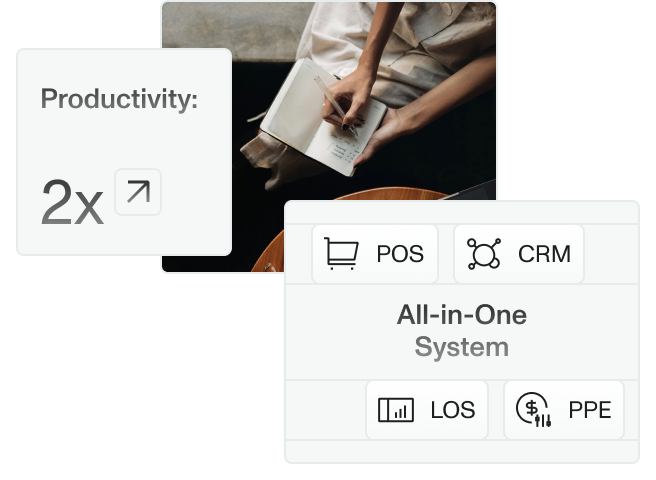Nothing shows the power of lender technology like the loan origination system (LOS). Where previous lenders had to grapple with never ending paperwork and spreadsheets, today’s professionals can streamline operations thanks to the LOS.
Why? A sophisticated LOS can manage nearly all aspects of loan origination, from the initial application to closing the loan. The software eliminates manual data entry requirements and introduces automation.
In this guide, we’ll explore what you need to know about using an LOS, from its definition to its core features and potential benefits and drawbacks.
Understanding Loan Origination Systems (LOS)
A loan origination system is a software application designed to handle the loan origination process. From credit decisions to document storage and preparation and automated emails – all of these tasks are taken care of by the LOS.
Switching to an effective LOS could supercharge productivity and reorganize your lending team so no one wastes time on tedious tasks.
LOS capabilities include:
Application Management
With an LOS, borrowers complete the loan application online. The system captures, qualifies, and organizes the data for rapid evaluation. If you enable automation, the LOS can disrupt application abandonment by sending reminders. On the back end, the LOS can also alert when the loan officer needs to complete an application task.
Credit Decisioning
LOS optimizes credit decisions by connecting to third-party credit bureaus and integrating rules-based engines that help assess creditworthiness. It can auto-underwrite traditional, conforming loans or use customized parameters for portfolio products.
This automated decision generates a quick and accurate response, increasing transparency and speed. Make decisions in days, not minutes.
Document Management
The LOS collects critical loan data and stores it in a centralized repository, making retrieval fast and easy 24/7. Applicants can securely upload documents, and you don’t have to worry about copying data across disparate software systems.
Version control, e-signatures, and secure sharing functionalities keep all parties up-to-date.
Compliance and Regulation Integration
One of the most essential functions of an LOS system is its ability to keep up with financial regulations. Adopting measures like the Truth in Lending Act (TILA) and the Equal Credit Opportunity Act (ECOA) is legally required, and compliance lapses may meet harsh penalties.
Streamlining Loan Origination Processes with LOS
Streamlining occurs through the combination of LOS features, including credit decisions and document and compliance management. Automation and creating a single source of truth for loan data are critical.
Automation lets your team focus on value-driven work while the LOS handles data entry and document management. A single source of truth reduces errors that trigger rework, slowdowns, or compliance failures.
Common Challenges with LOS
No matter the LOS technology you install, challenges may impede seamless functionality. Frustrating as these problems are, they’re fixable if you work with a quality system.
Common challenges include:
System Complexity and Navigation Issues
All of the bells and whistles coded into the modern LOS add to its complexity. There may be a learning curve before you feel adept at using the numerous modules.
The problem might get exacerbated by clunky navigation or a non-user-friendly interface. Confusion and underutilization are common while your team works out the kinks.
Integration Challenges with Existing Systems
Many large financial institutions’ LOS is just one part of their software landscape. Integration with other important mortgage vendors helps keep data consistent.
Smooth integration is critical to the system’s efficiency and integrity. Fortunately, you can find an LOS built with easy integration in mind.
Compliance Requirements and Regulatory Changes
Regulatory compliance involves frequently changing regulations. A static LOS that doesn’t update to reflect these changes has limited value.
Documentation and data must align with each regulation’s specific requirements. If your system isn’t updated, these documents will also be outdated.
User Adoption and Training
Implementing an LOS might be a major change for your organization, and your team can only adapt with heavy training and support. You should also prepare for slow adopters and those who still believe in the “old way.” Ignoring them could lead your team back to its earlier methods, defeating the purpose of the LOS implementation.
Strategies for Optimization
Overcoming the challenges associated with the LOS requires strategic management. Here are some actionable strategies to optimize LOS performance.
Workflow Optimization Techniques
Workflow design determines how quickly borrowers move through your borrower pipeline. Look at your current processes and see if you notice bottlenecks or lackluster KPIs. Optimization might include resequencing tasks, automating more steps, or clarifying your approval criteria.
User Experience Enhancement Strategies
An intuitive user interface is the key to user adoption. Training is necessary, but the system shouldn’t be needlessly complicated. To find out your team’s thoughts, engage in user testing and request regular feedback.
Automation and Integration Solutions
Automation is one of the most exciting tools in loan origination. It eliminates most manual, repetitive tasks and lessens the workload of originators and lenders. Integration, meanwhile, helps keep the LOS a “single source of truth” for loan data. Choose a LOS with modern automation and integration capabilities for optimal performance.
Compliance Management Best Practices
Compliance is a continuous state that should include regular audits and investing in compliance-focused LOS updates. Regular documentation is necessary, too, to keep track of obligations tied to specific transactions and customers.
Importance of Customization and Configuration for LOS Optimization
Lenders devise their risk strategies and ideal borrower profiles, so looking for a LOS that can be customized to your specifications is crucial. Proper configuration is equally important. Tailoring your LOS takes time but leads to even better efficiency and performance.
Real-World Examples and Case Studies Demonstrating Successful LOS Optimization Implementations
The LOS market is predicted to increase, reaching $12.2 billion by 2023. The surge is fueled by institutions implementing and adopting LOS software. One loan originator used Sonar’s LOS to leverage $145 million in loan funding within 12 months.
Future Trends and Considerations
The future brings hope for new technology. With a strong LOS powering your originations, better technology should equal more satisfied borrowers and less wasted time.
Evolving Needs of the Financial Services Industry and LOS Adaptations
Borrowers are tech-savvy now, and many don’t have patience for non-digital experiences. As this becomes more true, the LOS will become increasingly simple and user-friendly. Innovative AI tools like better autocomplete on applications and automation for document verification will become must-haves.
Considerations for Future-Proofing LOS Investments
Investing in your LOS is a significant commitment, so ensuring this investment remains viable for as long as possible is essential. Evaluating the longevity and adaptability of LOS platforms is a necessary step.
Good signs include compatibility with different devices, rapid updates for new regulations, and a modern architecture that can accommodate future integrations.
A capable LOS invites financial institutions to transform operations, improve the customer experience, and drive growth. However, it’s essential to recognize that achieving optimal performance requires ongoing effort.
You must prioritize user experience, stay proactive with compliance management, and make smart investments in emerging technologies. The strategies outlined in this guide can help your team overcome challenges and achieve successful LOS optimization.
So, take the time to research and invest in a suitable LOS for your institution’s needs and reap the rewards of improved efficiency and increased funding. Keep an eye on our blog to stay updated on the latest trends and developments in LOS technology.
Or, if you’re ready to check out Sonar’s LOS System, click here.







